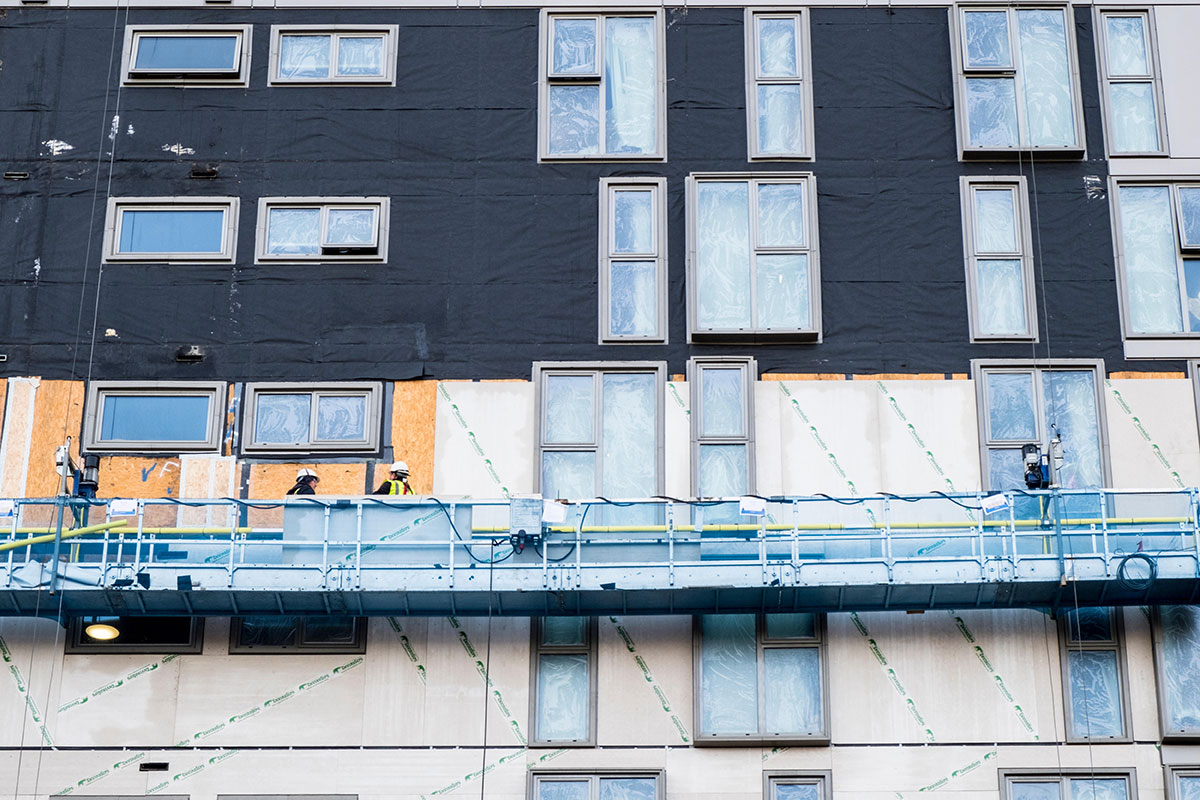You are viewing 1 of your 1 free articles
Asset management post Grenfell – what housing associations need to know
Grenfell, the Hackitt Review, the climate crisis… Asset managers have a lot to consider when deciding how to spend their limited resources, as Margaret Taylor discovers. Illustration by Andrew Nye and photography by Getty/Alamy
There were few surprises in the recommendations made by Sir Martin Moore-Bick when he issued his report from the first phase of the Grenfell Inquiry last month.
High-rise blocks must have robust evacuation plans in place and be equipped to send evacuation signals; fire doors in all residential buildings must be regularly inspected to ensure self-closers remain intact; internal signage has to not only be prominently displayed but presented in a way all residents will be able to understand; and, crucially, landlords must be compelled to “vigorously” remove the combustible cladding the government banned last year.
Given the scale of the tragedy that saw 72 people perish in their west London homes in June 2017, anything less would have been inadequate.
Yet when the tougher fire safety regulations envisioned last year by Dame Judith Hackitt are considered – along with the potential for phase two of the inquiry to recommend the use of sprinkler systems – it all adds up to a very expensive mix for social landlords.
Despite the budgetary pressures the changes will inevitable present, Angela Lockwood, chief executive of North Star Housing Group, believes housing associations will be happy to rise to the funding challenge.
“People will have been considering the Hackitt Review, but when you read the Grenfell Inquiry report in more detail, it raises its profile again, the horrors hit you again and it makes you think long and hard,” she says.
“I’ve said to my head of assets that we don’t have sprinklers in our extra care schemes and we aren’t obliged to have them, but can we get a price?
“This triggers the conscience and we’re thinking of going above and beyond what these reports are suggesting.”
Jesse Meek, head of asset and innovation at Sovereign Housing Association, notes that his organisation has been “spending robust sums of money responding to what’s been happening as a result of the tragic events at Grenfell”.
Much of that has focused on safety in the association’s 24 high-rise buildings, although Mr Meek admits there is a limit to how granular risk management can be.
“We have to be careful we don’t use up vital resources and consume ourselves in completely eliminating any risk,” he says. “We have to keep focused on good risk management – that’s quite a helpful thing to reflect on.”
There is no question that the requirements of the Hackitt Review and the Grenfell Inquiry must be acted on. But it is clear that with a new set of unrelated spending demands on the horizon, the question of what makes “good risk management” will come into sharper focus.
For example, in the immediate aftermath of the fire, some housing associations put some low-carbon obligations to one side.
But as Rose Bean, head of asset management at Yarlington Housing Group, notes there is now a more pressing need for funds to be diverted towards meeting local and national governments’ net-zero emissions targets.
Simultaneously, social landlords are having to prepare for the likelihood that they will be hit next year with a potentially large number of legal claims under the Homes (Fitness for Human Habitation) Act 2018 (FHHA), which came into force for new tenancies earlier this year but will extend to existing ones in March 2020.
Having to budget for both these things will colour how and when associations choose to implement other requirements.
“The low-carbon agenda is really interesting because the sector post-Grenfell largely retreated from that,” Ms Bean says.
She adds: “Because of the investment requirements coming out of the tragedy, the sector has been a bit slow, particularly with existing stock. That’s going to be one of the biggest issues to face the housing sector in the next 10 years, though.”
In the medium term, housing providers must focus on a government requirement to get all their homes up to an Energy Performance Certificate banding of C or above by 2030. That will typically involve spending money on loft and wall insulation and upgrading windows.
In the longer term, social landlords will have to think about how they contribute to their local authorities’ net-zero targets, some of which have been set for as early as 2028, as well as the UK government’s overall target, which has been set for 2050.
That could be easier said than done. Chris Paul, housing partner at the law firm Trowers & Hamlins, says few providers he has spoken to have allowed for costs such as installing electric vehicle charging points or large-scale changes such as the adoption of communal heating systems.
“We have to keep focused on good risk management – that’s quite a helpful thing to reflect on”
Jesse Meek, head of asset and innovation, Sovereign Housing Association
This could become problematic, he says, because “local authorities are declaring climate emergencies so they won’t look very keenly at developers looking to sidestep issues”.
Even if providers do start to factor in these changes, any plans that are put in place now could be thrown off course next year, if they find themselves at the receiving end of a large number of FHHA claims. At the moment, that remains an unknown quantity, but as the remedies available under the act include bringing affected properties up to a suitable standard and potentially paying compensation, it could prove costly for some.
Both Ms Bean and Mr Meek note that inevitably, claims management firms have already begun scouting the market looking for potential clients.
One such business is Manchester-based AWH Legal, which was set up with the backing of a US investment fund in 2017 with the specific aim of acquiring personal injury focused law firms. It has recently broadened its focus to include the pursuit of housing grievances on behalf of tenants.
An FHHA landing page on its website states: “The new act has made it easier for you to pursue a claim against your landlord for making you live in a state of disrepair and we can help.”
Mr Meek says Sovereign is confident it is meeting its statutory obligations, but “with the activity of legal campaigners talking to the public about their recourse through the act, I can’t say we won’t get any enquiries”.
Ms Bean at Yarlington agrees. “From the feedback we’ve been getting, particularly from solicitors, there will be a significant drive, a bit like PPI, to get customers,” she says.
Meeting net-zero carbon targets is important but few housing providers are allowing for costs such as installing electric vehicle charging points or large-scale changes such as the adoption of communal heating systems
“A problem for the sector could be around historical record-keeping. That’s an emerging issue.”
In light of so many conflicting demands, all of which will have to be met to some degree at least, the conundrum most providers are facing is how to pay for it all and whether pressure should be put on the government to help.
Ms Lockwood at North Star says the focus for her organisation will be on “how much you can squeeze from your own resources, how much from rent increases and how much extra grant you can get”.
Mr Meek notes that rents will have their part to play, particularly as the rent cap has been lifted. But he adds that “we will always want to encourage the government to create funding opportunities”.
“Housing associations can apply for funding such as the Warmer Homes Fund and Energy Company Obligation, which have been really instrumental in helping us start to tackle fuel poverty for our customers, as well as more efficient and environmentally friendly heating and insulation systems,” he says.
Ms Bean goes further, noting that the government should be required to do more to help the sector.
The government has provided a £400m fund to social landlords for cladding removal, but he believes there is room to push it for more help in paying for other cladding-related issues.
“There’s scope for the government to do more and they will be pushed in terms of the Spending Review,” she says. “There’s going to be an absolute need to address the wider issues in terms of compliance and failings of the regulatory system.”
“There’s going to be an absolute need to address the wider issues in terms of compliance and failings of the regulatory system”
Rose Bean, head of asset management, Yarlington Housing Group
However, Mr Paul does not think it is likely the government would be willing to bridge any funding gaps as it would be keen to avoid setting any precedents.
“Should government pay for cladding? That’s difficult,” he says.
“The investment is enormous and the initial action will be to remove the cladding, but then you’ve got to replace it with something.
“There’s going to be a cash call from a number of providers having to fund this stuff, but it would be difficult for the government to step in on this and not on other things.”
Whether government funding becomes available or not, it is clear that the conflicting demands on their resources mean associations will have to make tough choices about how to prioritise their spending.
While Ms Bean stresses that most decisions will start with safety as the priority, Mr Paul believes there will come a point when all the upgrading and retrofitting required to make sure buildings meet a changed and changing set of safety and energy standards will become prohibitively expensive.
He says that when that point is reached, landlords are likely to consider rationalising their existing stock and focusing their investments on new builds instead.
He says: “It’s early days with net zero, but we know that the built environment is a big part of the emissions the government is going to target and more is coming.
“We’re talking to clients about what they are doing about looking at stock and whether some properties are suitable to be upgraded to that standard.
“If it gets to the point where they are almost replacing every part of the building then it becomes better to take it down and start again. I think that will come.”
Ms Lockwood agrees that it can be difficult to justify repeatedly upgrading properties, especially if they still fall short of the standards new builds can achieve. However, she stresses that few in the housing sector would see demolition as anything other than a last resort.
“We’ve got a legacy of pre-1919 terraces and with some stock, it doesn’t matter how much you spend on it, it will never be very warm. That raises strategic questions,” she says.
Achieving EPC banding of C or better will involve installing loft and wall insulation and upgrading windows
“It might be that we’ll live with that because it’s as good as it gets or it might be that that’s not good enough and we’ll have to find a solution.
“At a recent meeting of the [National Housing Federation’s] North East Chief Executives’ Forum, someone said that new housing is the easiest to start working on, it’s the existing stock that’s the problem. But you don’t demolish really.
“In the North East, we’d only ever do that if it was in the local authority’s strategic plan. We might do it in small numbers where it makes sense, but there’s no big wholesale regeneration in the North East.
“Housing associations wouldn’t want to demolish because they’ve got existing communities. The preference would be to retain stock and I can’t see that changing.”
Nevertheless, it is clear that social landlords will stand a better chance of meeting all their existing and emerging obligations if they can tackle them from a standing start.
It is perhaps unsurprising then that last year, North Star made a commitment to build 500 new homes over a five-year period, spending £3m on 31 new builds in 2017/18, followed by £6m on 63 homes in 2018/19.
Sovereign, too, has increased the amount it is spending on new developments, with the £181m it invested in 1,208 new homes in 2017/18 rising to £238m in 1,543 homes in the most recent financial year.
Mark Washer, chief executive at Sovereign, told Inside Housing last December that the organisation, which had historically built 85% of its new homes under Section 106, would increasingly be adopting a land-led approach.
“It really isn’t a question of prioritising investment in existing stock over new build or vice versa – it’s about striking the balance and creating a virtuous circle”
Wayne Gethings, chief executive, The Wrekin Housing Group
Mr Meek says this is crucial if Sovereign is to be sure its homes will meet all the standards required of it.
“We’re committed to enhancing and developing the quality of new homes now and in the future and want to do more land-led development to make sure we can really control the quality to a greater extent than in the past,” he says.
Taking the lead on development, rather than relying on planning gain from a commercial developer, has another benefit – it helps generate the cash required to bring existing homes up to scratch.
Amy Shaw, partner at Trowers & Hamlins, says that for the registered providers she represents, that means “new build activity is running parallel to investment in existing stock”.
“Where registered providers are identifying that there might be significant remedial work to be done – and in some cases there’s an urgent need if there’s a risk-to-life situation – that costs money,” she says. “The way you get the money is by developing new stock and generating surpluses.”
Wayne Gethings, chief executive of The Wrekin Housing Group, says this creates a virtuous circle that sees the value of existing stock also play an important role when it comes to raising the cash needed for new developments.
For that reason, he says, one type of investment will never be prioritised over the other.
“For us, it really isn’t a question of prioritising investment in existing stock over new build or vice versa – it’s about striking the balance and creating a virtuous circle,” he says.
“By following a long-term strategy, we are in a position where these investments are mutually beneficial rather than at odds with each other.
“The general condition of our stock has a knock-on effect to its value. While much of the value of stock is based on rental income, some is attributed to its condition, so the better it is, the higher the value. From there, we can fund a new build programme.”
Ultimately, as Mr Meek at Sovereign says, the requirements faced by housing associations in the post-Grenfell, pre-net zero world may be onerous, but they will never be met if one type of asset is prioritised over another.
“There are stats out there that say somewhere between 70% and 80% of existing buildings will still be standing in 2050,” he says. “We can’t not invest in existing assets in response to what’s been happening. We can’t solve this only by enhancing the standards of new developments.”














